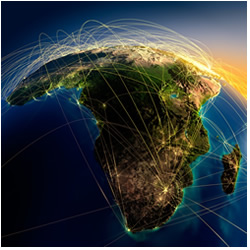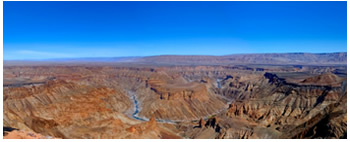Why, How, and Where to Travel in Africa
 Tourists may greatly enjoy going to popular tourist attractions — who doesn’t want to show off their selfies in front of the Eiffel Tower — but dedicated travelers usually are more interested in visiting places not exactly on the map.
Tourists may greatly enjoy going to popular tourist attractions — who doesn’t want to show off their selfies in front of the Eiffel Tower — but dedicated travelers usually are more interested in visiting places not exactly on the map.
While big cities and world landmarks may be fun, real travelers most look forward to small villages, unknown cultures, and real people in foreign places. Still, regrettably few avid travelers strive to tour one of the most fascinating and underappreciated vacation destinations in the world: Africa.
Africa is unbelievably rich in astounding natural scenery, grand untold history, and distinct vivid culture. Instead of journeying to well-trodden locales on your next trip, you should experience the glory and splendor of Africa, from the Cape of Good Hope to the Mediterranean Sea.
Safety Precautions
While Africa is certainly the path least traveled by regular tourists — which makes it a veritable haven for those looking for an authentic and satisfying trip — there is a reason certain regions are unpopular among those looking for a turn-key vacation. With unstable governments and widely-publicized disease, many travelers are wary to set foot anywhere on the continent, but these isolated issues shouldn’t dissuade you from taking the trip of a lifetime. Instead, you should be prepared for certain possibilities, which will mitigate their effect should they come to pass.
For example, it is essential that you visit your local Passport Health office to learn which vaccines will help you stay on your feet during your travels. Most doctors will suggest that travelers to developing nations in tropical climates receive vaccinations for typhoid, yellow fever, rabies, and malaria. In addition, while you are in Africa, you should be wary of the food and drink you consume to avoid becoming infected with cholera, dysentery, and parasites.
Similarly, to combat potential hazards like crime or violence that are present wherever you travel, it is wise to carry a satellite phone. Unlike cellphones that rely on terrestrial towers to provide signals, satellite phones ensure crisp, clear communication no matter where you roam because they receive reception from satellites that cover a broad swath of the globe. You can research satellite phone coverage maps to find a carrier that provides service to the destinations you will soon pass through.
Top Destinations
Abu Simbel, Egypt. While Upper Egypt boasts some of the ancient empire’s most recognizable architecture and artifacts just outside Cairo, for much of history, Lower Egypt — toward the country’s border with Sudan — was its own realm with its own breathtaking monuments.
Nowhere is this more evident than in Abu Simbel, which offers two extraordinarily ornate temples carved directly into a mountain of sandstone. The temples, which were constructed by Pharaoh Ramesses II to commemorate him and his wife, Queen Nefertari, after a particularly grueling military victory, are over 3,000 years old, but their giant statues of the pharaoh, Nefertiti, their children, and a handful of Egyptian gods and goddesses remain nearly as detailed as the day they were carved. While countless millions of Egypt’s visitors view the crumbling Sphynx and pyramids at Giza, you can see Egyptian architecture at its finest at Abu Simbel.
 Fish River Canyon, Namibia. The second largest canyon in the world, surpassed only by the Grand Canyon in the United States, Fish River Canyon is a stark testament to the unending power of nature. While the Grand Canyon is situated in the midst of a coniferous forest, Fish River Canyon was carved out of the yellow and orange Namibian desert, making its deep gashes even more impressive considering the meager trickle of water that flows through the Fish River during the dry season. Still, during the dry season, the water takes on a brilliant turquoise color, which contrasts beautifully with the hues of the sand and rock. Fit travelers have the opportunity to hike throughout the canyon and find even more secluded spaces to revel in nature’s majesty.
Fish River Canyon, Namibia. The second largest canyon in the world, surpassed only by the Grand Canyon in the United States, Fish River Canyon is a stark testament to the unending power of nature. While the Grand Canyon is situated in the midst of a coniferous forest, Fish River Canyon was carved out of the yellow and orange Namibian desert, making its deep gashes even more impressive considering the meager trickle of water that flows through the Fish River during the dry season. Still, during the dry season, the water takes on a brilliant turquoise color, which contrasts beautifully with the hues of the sand and rock. Fit travelers have the opportunity to hike throughout the canyon and find even more secluded spaces to revel in nature’s majesty.
Tsingy de Bemaraha Strict Nature Preserve, Madagascar. The large island nation of Madagascar off Africa’s southeast coast is a wonderland of bizarre natural spaces, but no region is more unique than the Tsingy de Bamaraha Nature Preserve. As a whole, Africa offers some of the world’s most fascinating wildlife, from elephants and giraffes to giant, graceful cats, but the inimitable biodiversity and landscape of Tsingy de Bamaraha offers something beyond the common safaris of the mainland.
Rightfully labelled a “cathedral of limestone” by UNESCO, the park is largely comprised of massive spires of rock that offer sanctuary to a bevy of rare species of flora and fauna. In fact, the base of the limestone needles form a completely disparate ecosystem from their peaks, which effectively doubles the importance of maintaining the integrity of the preserve. Fittingly, the name “tsingy” is an indigenous Malagasy word which roughly translates to “one cannot walk barefoot.” Still, shoed travelers are welcome to tour the labyrinthine rock forest and even camp within its naturally fortified walls.
